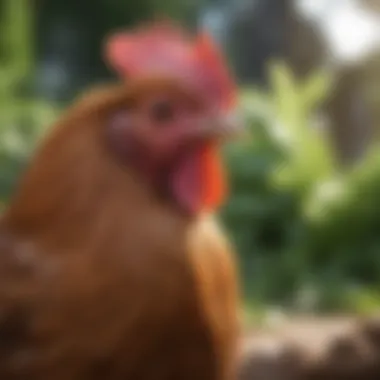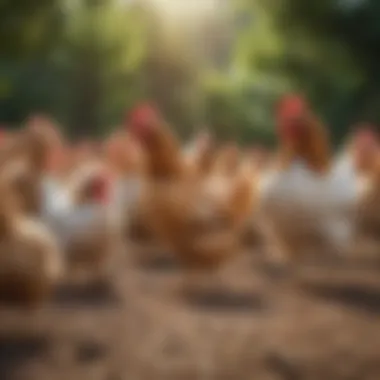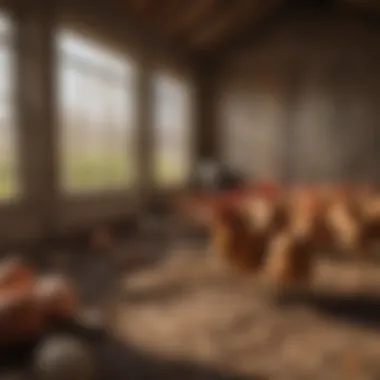Understanding Chicken Laying Age: Factors and Insights


Intro
Understanding the laying age of hens is crucial for any chicken keeper. The age at which a hen starts to lay eggs can greatly impact the management practices followed on a poultry farm. Several factors play a role in determining when chickens begin their laying cycle, including breed characteristics, environmental conditions, and nutritional input. Understanding these aspects helps both novice and experienced poultry farmers to optimize egg production in their flocks. This article will explore these dimensions to provide comprehensive insights.
Physiological Factors Affecting Laying Age
Hens typically reach maturity between five to six months, but this can vary significantly based on breed. For example, lighter breeds such as the Leghorn may begin laying eggs as early as 16 weeks, while heavier breeds like Orpington or Brahma may take longer, sometimes up to 26 weeks or more. Understanding these variations is essential for effective management.
Environmental Impact on Egg Laying
Environmental factors, including light exposure and temperature, significantly influence a hen's laying age. Hens require about 14 to 16 hours of light per day to stimulate egg production. Insufficient light can delay laying, while excessive heat can reduce overall productivity. Chicken keepers should ensure a controlled environment to promote timely egg production, which includes providing adequate lighting and regulating temperature, particularly in extreme weather conditions.
Nutrition and Its Role
Proper nutrition is foundational to healthy birds and timely egg laying. A well-balanced diet consisting of protein, vitamins, and essential minerals can promote earlier and more consistent laying patterns. Quality feed enriched with calcium is particularly crucial for shell development as hens begin laying.
Management Practices to Encourage Egg Laying
Effective management practices can further refine the age at which hens start laying. These practices include:
- Breeding Selection: Choosing the right breed based on your goals can enhance productivity.
- Environmental Control: Creating optimal living conditions helps to synchronize laying cycles.
- Nutritional Support: Ensuring that hens receive a balanced diet tailored to their laying phase.
- Health Monitoring: Regular check-ups help identify health issues that might impact egg laying.
By focusing on these key areas, chicken keepers can improve both the timing and quality of egg production. With the right approach, management practices can align with hens’ natural rhythms to enhance the overall productivity of your flock.
"Understanding both the physiological and environmental factors influencing laying age is key to successful poultry farming."
Culmination
The laying age for chickens is influenced by a variety of factors, including breed, environmental conditions, and nutrition. By acknowledging these aspects and implementing effective management strategies, poultry farmers can optimize egg production. This understanding not only benefits the profit margins of poultry farms but also contributes to the health and welfare of the hens.
Prelude to Chicken Laying Age
Defining Laying Age
Laying age is the specific developmental stage at which hens begin to produce eggs. It varies significantly among different breeds and can also be influenced by environmental factors. Typically, hens start laying eggs between the ages of five to six months. However, factors such as breed, genetics, and overall health determine this timeline. For instance, commercial breeds like the Leghorn may initiate laying earlier compared to heritage breeds, which might take longer. By understanding this concept, chicken owners can set realistic expectations regarding egg production.
Importance of Understanding Laying Age
Comprehending laying age is essential for several reasons. First, it directly affects egg production strategies. Knowing when to expect eggs allows farmers to plan marketing or use of the eggs effectively. Second, understanding the nuances of laying age helps in providing the right care at different growth stages, which can enhance overall flock well-being.
Furthermore, recognizing the signs of approaching laying age enables owners to meet nutritional and environmental needs more effectively. This knowledge can reduce stress among layers and improve egg quality. For example, ensuring proper lighting conditions and balanced feed can dramatically impact when the hens begin laying.
Understanding when chickens begin to lay eggs informs management practices and affects overall production efficiency. This knowledge, paired with good care, can maximize egg yield.
In summary, laying age is a significant aspect of poultry management. It influences both practices and outcomes in egg production. Therefore, delving deeper into genetic, environmental, and health factors will yield a comprehensive understanding of this critical topic.
Factors Influencing Laying Age
Understanding the factors that influence laying age in chickens is crucial for any poultry enthusiast or farmer. It allows for better management decisions that can enhance egg production. Various factors play significant roles, each bringing unique considerations. This section will delve deeply into these elements and their implications.
Genetic Factors
Genetics holds a predominant place in determining when hens start to lay eggs. Specific breeds exhibit different laying ages due to their genetic makeup. For instance, commercial layers like the Hy-Line Brown or Bovan Nera often begin laying earlier than heritage breeds such as the Rhode Island Red. This variation can be attributed to selective breeding aimed at optimizing egg production.
Understanding genetic factors helps in selecting the right breed according to one's production needs. This knowledge can save time and resources, ensuring that the right expectations are set from the beginning.


Environmental Influences
Environmental factors are equally important in influencing laying age. Factors such as light, nutrition, and climate can all impact the age at which chickens begin to lay eggs.
Lighting Conditions
Lighting is a key characteristic in a hen's laying cycle. Chickens are sensitive to light; they need a certain amount of light to trigger egg laying. Most hens require about 14 to 16 hours of light per day to optimize their egg-laying potential. Providing consistent light conditions can be a beneficial management strategy, especially in environments where natural light varies.
Artificial lighting can help extend daylight hours, promoting earlier and consistent laying. However, it requires careful management to prevent stress and discomfort in the birds.
Nutritional Requirements
The diet of laying hens significantly impacts their reproductive cycle. Proper nutrition is essential not just for health but also for egg production. Hens that receive a balanced diet rich in calcium, protein, and vitamins tend to reach laying age sooner.
Choosing high-quality feed specifically formulated for layers ensures that hens get the right nutrients. A deficient diet can delay the onset of laying, impacting productivity negatively. Thus, understanding their nutritional requirements is a critical factor in managing laying age effectively.
Temperature and Climate
The surrounding temperature and overall climate also play a substantial role in laying age. Chickens thrive in moderate weather. Extreme temperatures, whether hot or cold, can affect their health and stress levels, pushing back their laying age.
For instance, in excessively cold climates, hens may take longer to start laying eggs unless proper heating is provided. Conversely, in hot conditions, it can lead to heat stress, which can inhibit production. Therefore, adapting management practices according to climate conditions can support optimal laying age.
Health and Developmental Factors
Health and wellness significantly affect when chickens begin to lay. These factors encompass not just the overall well-being of the hens but specific health interventions as well.
Vaccination Effects
Vaccination is crucial in maintaining a healthy flock. Immunizations can protect against diseases that might impede development and laying capabilities. Chickens that are properly vaccinated generally exhibit less stress and therefore tend to reach laying age without unnecessary delays.
Incorporating vaccinations as part of a regular health protocol strengthens the flock’s overall resilience. Thus, this aspect is vital for optimal production on any farm.
Stress and Disease
Stress and disease represent hindrances to achieving optimal laying age. Chickens under stress—due to overcrowding, handling, or poor living conditions—may delay or halt egg production. Recognizing the signs of stress and promptly addressing the causes is vital.
Additionally, disease outbreaks can have profound impacts on overall flock performance, including egg-laying capabilities. Maintaining a stress-free, healthy environment is essential for ensuring that chickens achieve their natural laying age in a timely manner.
Heeding these factors increases the likelihood of achieving optimal egg production while ensuring the well-being of the chickens.
Typical Laying Ages for Chicken Breeds
Understanding the typical laying ages for different chicken breeds is essential for anyone serious about poultry management. This section provides valuable insights into how varied breeds develop and when they begin egg production. Each breed has unique traits and maturation timelines. Knowing these specifics allows owners to plan better and manage expectations around egg production.
Commercial Breeds
Commercial breeds are designed specifically for efficiency in egg production. The most common varieties, such as the Leghorn, Rhode Island Red, and Austra White, typically start laying around 18 to 20 weeks of age. These breeds are favored in industrial settings due to their rapid growth rates and high egg yield.
The ability of these birds to produce eggs reliably changes the profitability of poultry farming. Therefore, understanding the specific laying ages helps farmers anticipate production schedules and meet market demands efficiently.
It is important to ensure that commercial breeds receive a balanced diet with proper nutrition. Factors such as lighting and environmental conditions play a crucial role during the initial months. Optimizing these can lead to increased productivity.
Heritage Breeds
Heritage breeds, like Orpingtons, Plymouth Rocks, and Sussex, usually have longer maturation periods. They may typically start laying between 20 to 24 weeks. These breeds often offer unique flavors and higher-quality eggs as compared to commercial varieties.
Many poultry enthusiasts choose heritage breeds for their ability to thrive in free-range environments. They are often seen as more resilient to diseases, which can impact laying age positively in the long run.


By understanding the typical laying ages of heritage breeds, chicken keepers can appreciate the additional time required to nurture these birds. This knowledge is vital in managing expectations related to egg production.
Bantam and Specialty Breeds
Bantams and other specialty breeds, such as Silkies and Cochins, have varying laying ages, typically starting between 16 to 20 weeks. These breeds are smaller in size and may not produce eggs in significant quantities, but their unique characteristics and behavior often charm chicken enthusiasts and backyard keepers.
It is worth noting that the egg-laying frequency of bantams often differs from larger breeds. Understanding these nuances helps in creating a diverse flock that offers both aesthetic and functional value.
In summary, recognizing the typical laying ages across different chicken breeds benefits anyone involved in poultry farming or backyard keeping, allowing for effective management and realistic expectations.
Signs of Approaching Laying Age
Understanding the signs that indicate a chicken is nearing its laying age is essential for optimizing egg production in any flock. Recognizing these signs can help poultry keepers prepare for the eggs’ arrival. By being observant about the physical and behavioral changes in hens, one can adjust management practices to ensure hens are supported adequately as they reach this critical point in their life cycle.
Physical Changes
Comb and Wattle Development
The comb and wattle of hens are important physical features that signify their maturity. As chickens mature, the comb and wattle typically grow larger and more vibrant in color. This change indicates that the hen's reproductive system is becoming active and is readying itself for egg production. A bright, well-developed comb and wattle can alert keepers that the hen is getting closer to laying age.
Notably, the prominence of these features serves as a non-intrusive indicator that can be easily monitored. The health of a chicken’s comb and wattle can reflect overall health. If they appear dull or shriveled, it may indicate underlying health issues that need addressing, potentially delaying the onset of laying. Therefore, a noticeable increase in their size and color is a beneficial signal for poultry keepers as it often correlates with readiness for laying.
Pelvic Bone Changes
Another physical change to observe is the development of the pelvic bones. As a hen approaches laying age, the pelvic bones begin to widen. This change occurs so that the hen can accommodate the passage of eggs. Checking the spacing between these bones can give a clear indication of a hen’s readiness to lay. A hen whose pelvic bones are well-separated suggests she is nearing her laying time.
The practical advantage of monitoring this change lies in its direct connection to egg-laying capability. If pelvic bones are not widening appropriately, it may signal health problems, necessitating interventions. Conversely, hens exhibiting normal pelvic bone development are likely to lay on schedule, benefiting overall egg production.
Behavioral Indicators
Nesting Behavior
Nesting behavior is a crucial indicator that hens are getting ready to lay eggs. When hens begin to exhibit interest in nesting, you may notice them spending more time in their nesting boxes or scratching the ground in a specific area. This instinctual behavior signals that they are preparing to lay. If hens start behaving this way, it is a sign that you should ensure they have a comfortable and safe nesting environment.
Cultivating a conducive nesting area can lead to improved egg production. A clean, quiet space encourages hens to feel safe while laying, resulting in healthier eggs. Observing hens during this period can give insights into their stress levels, which can affect productivity.
Increased Activity Levels
As chickens approach their laying age, they often become more active. An increase in energy generally corresponds with a hen's readiness to start the laying process. This heightened activity may include more running, flapping, and even vocalizing more than usual.
Recognizing this change is essential since it can reveal both excitement and readiness for laying eggs. However, increased activity can also lead to territorial disputes or stress if hens do not have sufficient space. Thus, providing adequate room for movement is crucial during this period.
Monitoring these signs carefully not only allows for timely egg production but also ensures healthier and happier hens.
Ultimately, understanding the signs of approaching laying age is not just about preparing for egg production; it shapes holistic chicken management strategies. By attending to the physical and behavioral changes, poultry owners can enhance their farming practices and ensure optimal conditions for their birds.
Optimal Management Practices for Encouraging Laying
Optimal management practices play a crucial role in maximizing the egg production potential of hens. By focusing on specific elements such as nutrition, lighting, and stress reduction, chicken keepers can create an environment conducive to early and consistent laying. Understanding these practices is essential for both novice and experienced poultry farmers aiming to enhance their flock's productivity. Each element contributes significantly to the overall health and productivity of the birds, leading to better outcomes in egg quantity and quality.
Proper Nutrition and Feed
Proper nutrition is foundational when it comes to encouraging laying in chickens. Hens require a balanced diet that supports their reproductive health. Key components of their diet should include:
- High-quality protein sources: Protein is vital for the formation of eggs. Including sources such as soybean meal and fish meal in feed can support optimal laying.
- Essential vitamins and minerals: Vitamins such as A, D3, and E along with minerals like calcium and phosphorus enhance various biological functions, including egg production.
- Layer diets: Specialized layer feeds are designed to meet the nutritional needs of laying hens, usually containing higher calcium levels for strong eggshells.


Feeding hens at consistent times every day also supports their laying schedules. The availability of clean, fresh water is equally important and should be readily accessible.
Lighting Management Strategies
Lighting management is another significant factor. Hens are sensitive to light, which affects their reproductive cycles. Implementing proper lighting strategies can help ensure that hens reach their laying age sooner. Consider the following:
- Consistent light exposure: Hens thrive on a stable lighting schedule. Providing 14-16 hours of light per day is often recommended to stimulate laying.
- Natural and artificial light: Combining natural daylight with artificial light during darker months improves the laying rate. Using timers can help maintain a consistent light schedule.
- Gradual adjustments: Abrupt changes in lighting can disturb hens. Gradually increasing light intensity mimics natural conditions and leads to better egg production.
By managing the light properly, farmers can help their flocks maintain their biological clock, thus optimizing laying performance.
Stress Reduction Techniques
Stress has adverse effects on laying hens, potentially delaying or reducing egg output. Addressing stressors is critical in encouraging successful laying. Here are effective stress reduction techniques:
- Stable living conditions: Ensuring a calm environment helps reduce anxiety. This includes appropriate space, clean surroundings, and proper ventilation in the coop.
- Social structures: Hens are social animals. Maintaining proper flock dynamics helps in reducing stress and anxiety. Introducing new birds carefully and observing interactions can mitigate conflicts.
- Minimizing disruptions: Avoiding sudden loud noises or disruptions near the coop can prevent unnecessary stress. Regular handling and gentle interactions also foster familiarity and reduce fear in hens.
By focusing on these practices, chicken keepers can support their hens' well-being and productivity, ultimately leading to a more efficient and enjoyable poultry operation.
Remember, managing nutrition, lighting, and stress are not singular practices—they work together to create a holistic environment that fosters healthy laying hens.
Consequences of Early or Late Laying
Understanding the consequences of early or late laying in chickens is crucial for poultry keepers. The timing of a hen's first egg can significantly influence both the quantity and quality of production. Managing these factors effectively can lead to better outcomes for those involved in poultry farming.
Impacts on Egg Quantity
Laying eggs earlier than expected can result in various issues. Young hens may not yet have fully developed their reproductive systems. This underdevelopment can lead to inconsistent laying patterns and lower overall egg production. Conversely, if hens begin laying too late, they might miss optimal production timelines, which affects the total yield throughout their laying period. Other factors are also involved in this aspect, including the breed of chicken, as some types are naturally predisposed to lay earlier or later than others.
- Inconsistent Production: Early layers may produce eggs irregularly, making it hard to predict production times.
- Volume Issues: Late laying can diminish the overall quantity of eggs that can be harvested during a hen's laying cycle.
Furthermore, environmental conditions play a pivotal role; anxiety-ridden hens or inadequate nutrition can lead to delayed or sporadic laying. Keeping an eye on these metrics can help optimize egg quantity across the board.
Egg Quality Considerations
Quality is often as critical as the quantity in poultry harvesting. Hens that start laying too early might produce smaller eggs or those with thinner shells. On the other hand, hens that lay too late may produce eggs that are not as nutritious or have a higher chance of being defective.
Factors influencing egg quality include:
- Shell Thickness: Early layers often experience underdeveloped shells.
- Nutritional Value: Late laying eggs can lack essential nutrients due to insufficient time to accumulate resources in the hen's body.
- Taste and Freshness: Freshness is paramount in egg quality, and there is a window of production in which eggs are optimal in quality.
In essence, both the timing of the laying age and the health of the hens are pivotal to ensuring high-quality production. Observing the hens closely can reveal patterns, allowing for adjustments in care and feeding to maintain optimal egg quality.
The balance between quantity and quality is essential for a productive poultry operation. A careful approach considering both early and late laying ramifications can yield better results in the long term.
A thorough understanding of these consequences aids poultry keepers in making strategic decisions about their flock management, ultimately enhancing efficiency and productivity.
End and Future Directions
Summation of Key Insights
Throughout this article, several significant insights have been highlighted:
- Influence of Genetics and Environment: Genetic predispositions play a vital role in determining when chickens will begin to lay eggs. Understanding the specific breed's expectations helps set realistic benchmarks for egg production.
- Signs of Maturity: Recognizing physical and behavioral indicators of approaching laying age allows caretakers to adjust management practices accordingly. Monitoring these traits can enhance egg yield and quality.
- Impact of Management Techniques: Proper feeding, lighting, and stress management positively affect the timely commencement of laying. Implementing best practices can prevent early or late laying, which can have long-term consequences.
"The successful management of laying age not only maximizes output but also promotes the welfare of hens."
Potential Areas for Further Research
The dynamic nature of poultry science opens many avenues for research. Future studies might focus on:
- Breeding Programs: Investigating crossbreeding techniques that optimize laying age without compromising health.
- Nutritional Studies: Evaluating specific dietary needs during different life stages could yield insights into improving laying age.
- Environmental Interactions: Further examination of how varying temperature and humidity levels affect laying onset could guide better housing designs.
These areas present opportunities to enhance not only individual flocks but also the broader field of poultry production, ensuring sustainability and efficiency in egg production.







